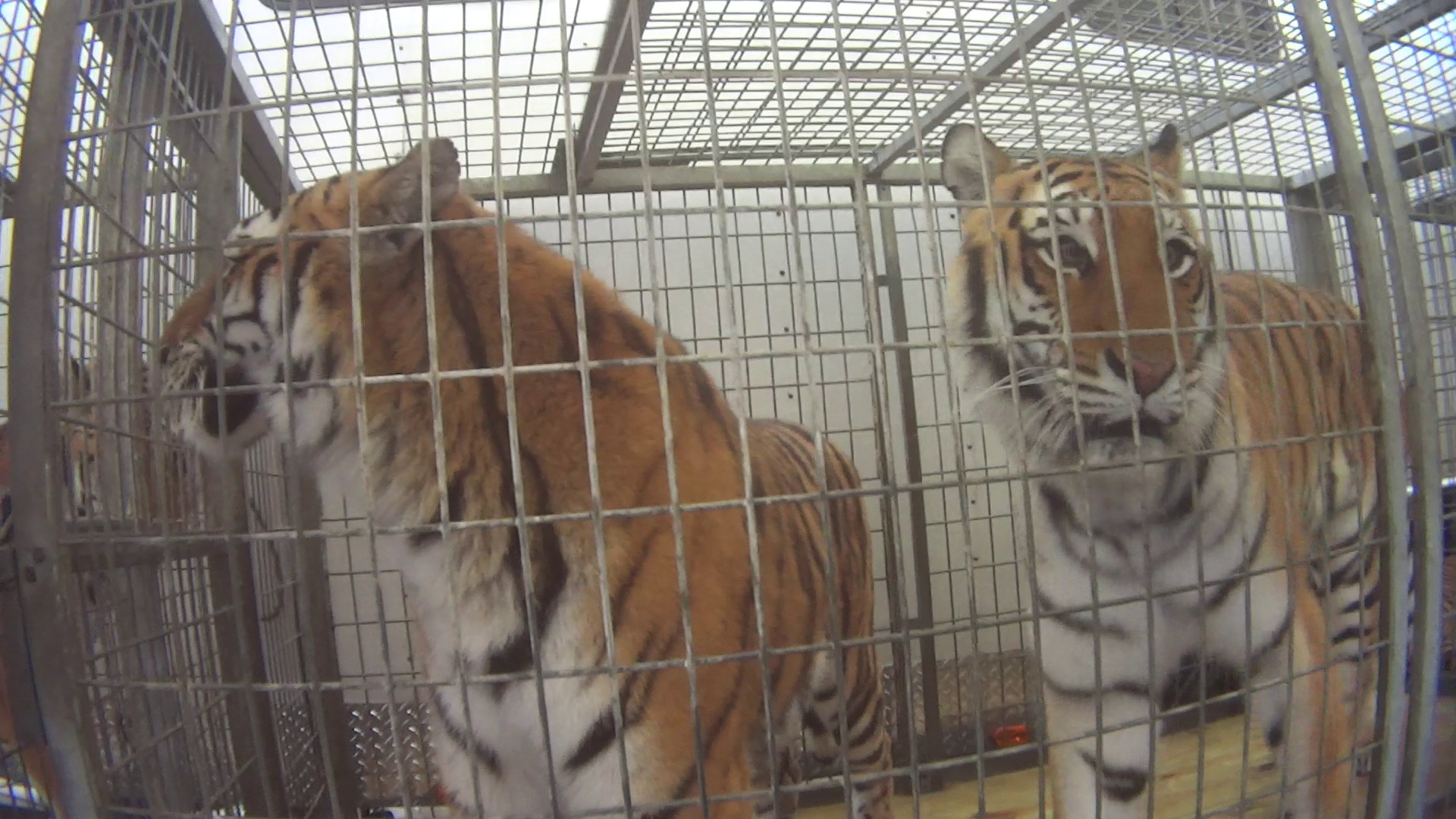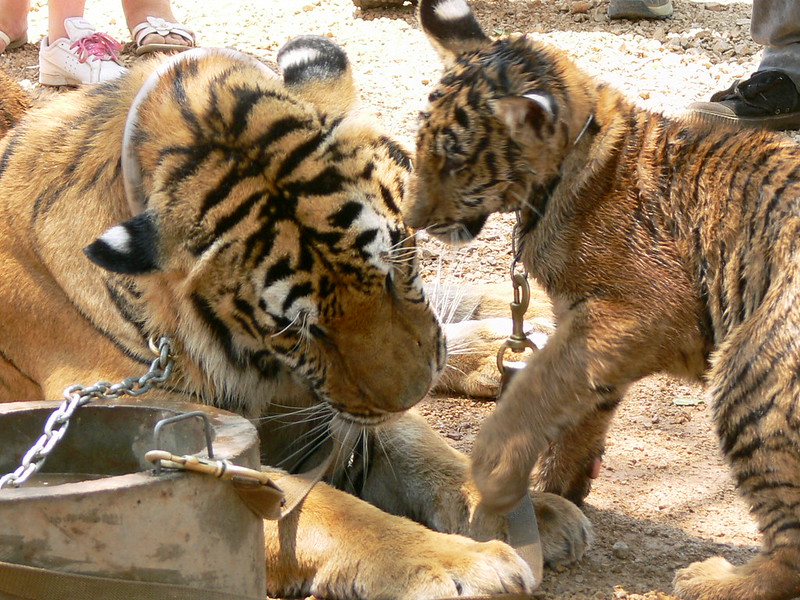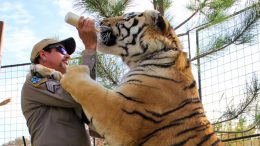Last month Netflix unleashed its captivating but sensationalized docuseries, Tiger King: Murder, Mayhem and Madness. The public, hungry for something new to binge-watch while they sheltered in place in the developing pandemic, quickly ate it up and made it a pop-culture sensation in a wave of social-media posts, memes and virtual water-cooler discussions.
But amidst all this amusement, shock, titillation and general confusion, the tragic story of the tigers at the heart of Tiger King has been eclipsed by the outsized egos of their human captors.
Looking beyond the “Hatfields and the McCoys” approach of the series to examine the issues the program fails to dig into, we find several key lessons about the threats tigers and other charismatic species face in a world that values them more as entertainment than as wild animals and living creatures.
1. The Tiger Trade Is Alive and Well in the United States.
Tiger King — centered on Oklahoma’s Greater Wynnewood Exotic Animal Park (more commonly known as the G.W. Zoo) and its operator, the self-anointed “Joe Exotic” — offers a revealing view into the forces and actors driving what could be called a tiger crisis in the United States.
Through murky underground markets, captive tigers have become commodities — sold, kept and exploited with little in the way of regulation of their care and breeding. This unregulated commerce, centered on one of the most endangered species in the world, has resulted in more tigers living in captivity here than remain in the wild in Asia. Actual numbers on private ownership of tigers are notoriously difficult to obtain, but the World Wildlife Fund estimates 5,000 of the big cats live in captivity in the United States.
This figure is particularly stunning when you consider that just an estimated 3,900 tigers remain in the wild.
And as Tiger King demonstrates, the lives of these captive wild cats are marked by cruelty, abuse, exploitation and — frequently — early death.
The sad reality is that most of these captive-bred cats grow up to become too big and too dangerous, not to mention to expensive, for amateurs to keep safely. All too often they end up in one of several already over-capacity legitimate rescue sanctuaries where their incredible dietary and care needs become enormous burdens.
And that’s if they live long enough to reach that point.
2. Roadside Zoos Do Not Contribute to Conservation
Over the course of the events depicted in Tiger King, Joe Exotic and another featured tiger exhibitionist, Doc Antle, make several claims that their breeding of rare tigers helps the species because they’re, well, making more tigers. Breeders and private owners have made similar claims for years.
Sadly, that’s far from the truth. In reality big-cat breeding programs stewarded by private owners are not beneficial to species conservation.
Tigers raised in private hands or at facilities like G.W. Zoo hold no potential value for efforts to bolster remaining wild tiger populations. Captive cats of unknown provenance cannot be included in carefully managed projects of conservation breeding, genetic banking, or any sort of program to be released into the wild.

In the United States, conservation breeding and genetic-banking programs are managed by the American Zoological Association, which maintains rigorous standards, records, genetic histories and life histories on individual animals and their progeny to ensure the health of species. There are five subspecies of tiger in the wild, and the accredited global program for their captive breeding works diligently to maintain the genetic diversity and rigor within each subpopulation.
Private breeding facilities like G.W. Zoo have no concern for genetic conservation and frequently crossbreed subspecies for the largest litters or (to them) most desirable characteristics. Two of the most common outcomes of these non-scientific, opportunistic programs are breeding for recessive characteristics like with white tigers or worse yet, the creation of hybridized cats like the “liger” (lion/tiger) as crowd-pleasing curiosities. The AZA condemns not only the breeding of such inter-species hybrids, but also the breeding of white tigers, which are not a subspecies but the result of severe inbreeding that leads to shortened lives, often plagued with health defects. All white tigers are born and bred for profit.
Of course, the very fact that these cats are “forbidden” and rare makes them that much more desirable to collectors.
Even the big cats raised in conditions specifically and scientifically developed for release into the wild have rarely been successful. The very few instances of tigers being successfully released required hundreds of thousands of dollars per animal in specifically built facilities, and the cases of greatest success have not involved captive-bred animals but cats who were born in the wild (and therefore possess the necessary survival instincts).
3. Selfies Have Become the New Trophy Hunts
Through the lenses of both the documentary crew and Joe Exotic’s self-produced content, Tiger King reveals how his zoo and other for-profit establishments attract visitors willing to pay extraordinary sums of money for the opportunity to interact with tigers. This has become, in many ways, a readily accessible hunting safari for the average Joe — and one with extraordinary appeal to those immersed in social media.
The G.W. Zoo and other similar unaccredited venues have become spaces for patrons to experience a sense of power over nature. Here they can claim authority to touch the untouchable through cub petting; engage in transgressive behaviors like swimming with young tigers; take the now-(in)famous “tiger selfies”; and watch self-styled “celebrity” zookeepers interact with full-grown cats in a spectacular expression of outsized and misplaced ego.
As the popularity of the docuseries itself reveals, the visceral thrill of tiger proximity has moved beyond embodied experience into social media. The trophies that visitors claim through these visits — coveted selfies with tigers and other wild animals —are an in-demand commodity within the thriving attention economy. As this plays out in social media, it spurs users to pursue ever more fantastic and engagement-worthy photos.
Tiger selfies may look harmless, but they represent an imbalanced, unnatural relationship between humans and large carnivores. They can turn up anywhere online, but they’re perhaps most infamously deployed in online dating platforms, which abound with profile photos of (typically) men and (drugged) tigers. In this context they represent an attempt to appear virile and desirable — a way for men to claim their conquest over nature. These images have themselves inspired a tongue-in-cheek meme culture mocking men who associate proximity to an incapacitated tiger to their own performative masculinity — and these very connections to Joe Exotic’s own personal use of tigers in the construction of his public image hasn’t escaped the attention of audiences.
The pervasive positioning of wildlife as objects of entertainment trickles down onto our screens, big and small, where it warps our perceptions of the place of wildlife in the modern world. The ever-urbanizing population in the United States and other parts of the world has resulted in a global extinction of experience. No longer do we experience nature in nature; instead, our exposure to wildlife and wild things takes place through the plastic and glass of our computer and television screens. Experience has been replaced by pixels.
This has become especially true for our relationship with large carnivores. Media channels promote a wildlife-as-performer notion that wild animals exist chiefly to put on shows for people. It’s evident not just in Tiger King but in the daily news, where we frequently see tourists in national parks approach bears, bison, moose and other dangerous wildlife — again, for selfies.
This imperils people, wildlife and even the parks’ ability to stay open. For instance, Waterton Canyon in Denver, Colorado was forced to close for a time due to its inability to stop potentially dangerous behaviors of visitors seeking bear selfies.
Even if tourists aren’t quite waiting for a show like the one the now-jailed Joe Exotic used to put on, they’re still holding on to an expectation of non-threatening interactions. Thousands of hashtagged #tigerselfie posts to social media, accompanied by similar #bearselfie, #bisonselfie shots, indicate posters’ expectations of wild animals to stay still and to cooperate — whether in “controlled” environments or in the wild.
4. This Is Not Just a U.S. Problem
While Tiger King focuses on the United States, troubled interactions with wildlife are a global phenomenon, boosted in part by the voracious demands of a competitive global tourism market (at least, pre-pandemic). From the Amazon to South Africa to Thailand, wildlife petting and photo ops put animals, humans and entire ecosystems in harm’s way.

The welfare of individual animals, obviously, is a pressing concern. Equally concerning are systemic harms to the conservation of the species like tigers. These feline-profiteering operations fuel illegal international wildlife trade for the pet market, and the removal of animals from the wild affects population dynamics and the functioning of entire ecosystems. The United Nations cited this as one of most significant threats to conservation worldwide. As UN Secretary-General António Guterres noted on 2018’s World Wildlife Day (a day dedicated to the big cats), “We are the cause of their decline, so we can also be their salvation.”
He added that the UN’s Sustainable Development Goals, which address global challenges including climate change and poverty, “include specific targets to end the poaching and illegal trafficking of protected species of wild fauna and flora.”
This trade isn’t limited to tigers, although they remain a favorite in the trade. Cheetahs and lions are widely circulated in this global market, as well as other big cats (jaguars, leopards) and a plethora of small cat species (Asian leopard cat, ocelots). Countless amphibians, reptiles, birds, primates and other mammals are also ensnared in the global circulations of animal bodies.
5. Good Documentaries Inspire Change. Tiger King Does Not.
While the human protagonists/antagonists cast in Tiger King’s Greek tragedy are woven together with the connective threads of tiger-keeping, their ardent disagreements and ongoing social-media-boosted battles reflect personal projects of ego more than concern for others, including the big cats.
While the end result is, arguably, entertaining, it undermines any potential the film might have had to be a force for ethics around endangered tigers and other trafficked species.
Unlike 2013’s Blackfish — another wildly popular wildlife documentary, but one that placed the experience of animals in captivity in the foreground and ultimately inspired a groundswell of protest that nearly bankrupted for-profit aquarium/theme park SeaWorld — the tiger’s tale in Tiger King is subsumed within a sordid story of power and abuse. It’s hard to imagine audiences taking away from this series a conviction that there’s a deep-seated need for systemic change in how we treat wildlife — although some activists and even Congressmen have tried to use the program to drum up support for the long-stalled Big Cat Public Safety Act, which if ever passed would ban private tiger ownership and roadside zoos.
Beneath the frivolity of meme culture that surrounds it, Tiger King is a deeply disturbing look into the private ownership of captive-bred tigers and other big cats and a grim reflection of the larger issues that entice eager patrons to spend their dollars and share vanity photos of themselves with captive cats. It’s a shame we need to look so far beyond its surface offerings to expose those undercurrents.
The opinions expressed above are those of the author and do not necessarily reflect those of The Revelator, the Center for Biological Diversity or their employees.
![]()



